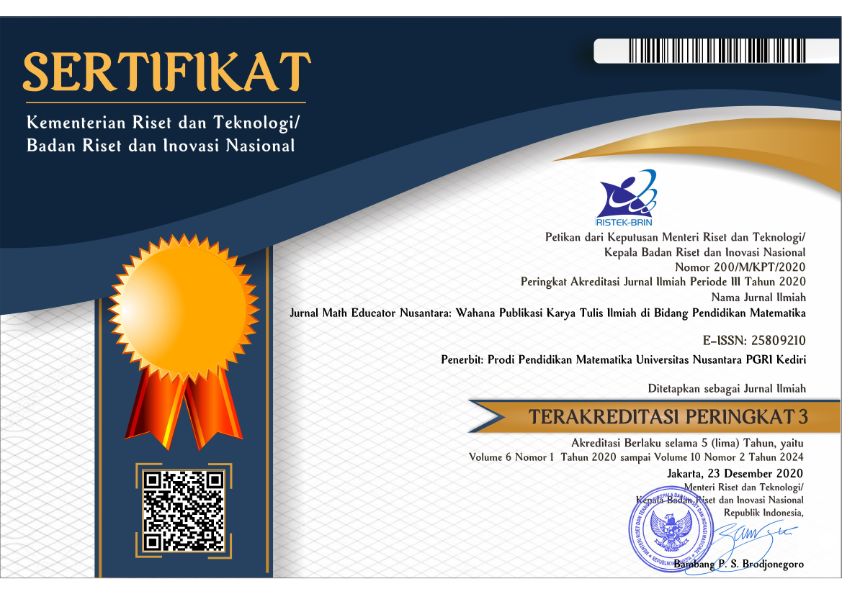Problem Solving Through the RME Approach for Students at Tarbiyatus Shibyan
DOI:
https://doi.org/10.29407/jmen.v10i2.23065Keywords:
RME Approach, Concept to Understanding, Mathematics LearningAbstract
This research aims to describe the improvement in mathematical problem solving in fourth grade students at MI Tarbiyatus Shibyan through the use of the RME approach. This type of research is Classroom Action Research (PTK) which is implemented over two cycles where each cycle consists of three meetings. Each meeting consists of four stages, which include: 1. Planning; 2. Acting; 3. Observing; and 4. Reflecting. The subjects in this research were fourth grade students at MI Tarbiyatus Shibyan Baureno. The data collection techniques used were through interviews, tests and observations. In the pre-cycle, the average student problem solving was 35 with a completion percentage of 0%. Furthermore, in cycle 1 the average increased to 61 with a completion percentage of 40% and in cycle II it increased again to 84 with a completion percentage of 90%. Thus, it can be concluded that the RME Approach is able to optimize students' mathematical problem solving in mathematics learning
References
Aldiyansyah, A., Rahmatulloh, I., & Alviandini, L. (2024). Modifikasi Model Pembelajaran Discovery Learning Dengan StrategiGufran, G., & Mataya, I. (2020). Pemanfaatan E-Modul Berbasis Smartphone Sebagai Media Literasi Masyakarat. JISIP (Jurnal Ilmu Sosial Dan Pendidikan), 4(2). https://doi.org/10.58258/jisip.v4i2.1060
Khoirotunnisa’, A. umi, & Irhadtanto, B. (2019). Pengaruh model pembelajaran Flipped Classrom Tipe traditional Flipped terhadap Hasil Belajar Matematika Siswa pada materi bangun ruang sisi datar. Jurnal Math Educator Nusantara: Wahana Publikasi Karya Tulis Ilmiah Di Bidang Pendidikan Matematika, 5(2). https://doi.org/10.29407/jmen.v5i2.13484
Listiawati, N., Sabon, S. S., Siswantari, Subijanto, Wibowo, S., Zulkardi, & Riyanto, B. (2023). Analysis of implementing Realistic Mathematics Education principles to enhance mathematics competence of slow learner students. Journal on Mathematics Education, 14(4), 683–700. https://doi.org/10.22342/jme.v14i4.pp683-700
Arianto, R., Haryadi, E. F., & Sarassanti, Y. (2022). Analisis Kemampuan Pemecahan Masalah Berdasarkan Langkah Polya Pada Materi Program Linear Kelas X Smk Bina Kusuma. AL KHAWARIZMI: Jurnal Pendidikan Matematika, 2(2), 11.
Cahyadi, M. R., Darmayanti, R., Muhammad, I., & Sugianto, R. (2023). Rubrik Penilaian Tes Esai dari Kemampuan Pemecahan Masalah Matematika. Jurnal Sains Dan Pembelajaran Matematika, 1(2), 39.
Elwijaya, F., Harun, M., & Helsa, Y. (2021). Implementassi Pendekatan Realistic Mathematics Education (RME) di Sekolah Dasar. Jurnal Basicedu, 5(2), 746.
Gufran, G., & Mataya, I. (2020). Pemanfaatan E-Modul Berbasis Smartphone Sebagai Media Literasi Masyakarat. JISIP (Jurnal Ilmu Sosial Dan Pendidikan), 4(2). https://doi.org/10.58258/jisip.v4i2.1060
Hadi, S., & Novaliyosi, N. (2019, November). TIMSS Indonesia (Trends in international mathematics and science study). In Prosiding Seminar Nasional & Call For Papers, 563.
Herawati, Z. R., Zakiah, L., & Sumantri, M. S. (2024). Survei Minat Literasi Baca Terhadap Kemampuan Membaca Siswa Kelas Rendah Di Sekolah Dasar. Pendas: Jurnal Ilmiah Pendidikan Dasar, 9(2), 780.
Hutasuhut, S. H. (2022). Peranan Statistika Dalam Penelitian Pendidikan Matematika. MES: Journal of Mathematics Education and Science, 7(2), 65.
Mayasari, N., & Khoirotunnisa, A. U. (2018). Efektivitas Model Penemuan Terbimbing dengan Menggunakan Tugas Superitem terhadap Kemampuan Pemecahan Masalah Matematika Mahasiswa. Journal of Mathematics Education and Science, 1(2), 56.
Megawati, Y. P., & Ratnaningsih, A. (2023). Modul Matematika Berorientasi Pemecahan Masalah Polya Pada Kelas V Sekolah Dasar. Edukasiana: Jurnal Inovasi Pendidikan, 2(2), 115.
Novianti, E., Yuanita, P., & Maimunah, M. (2020). Pembelajaran Berbasis Masalah Dalam Meningkatkan Kemampuan Pemecahan Masalah Matematika. Journal of Education and Learning Mathematics Research (JELMaR), 1(1), 72.
Pertiwi, R. A., Kusmanto, B., & Ayuningtyas, A. D. (2020). Upaya Meningkatkan Kemampuan Pemecahan Masalah dan Hasil Belajar Matematika Menggunakan Metode Problem Solving. UNION: Jurnal Pendidikan Matematika, 8(2), 168-169.
Putri, S. M. S., Fadhilaturrahmi, F., Rizal, M. S., Surya, Y. F., & Marta, R. (2024). Penerapan Model Realistic Mathematic Education (RME) untuk Meningkatkan Kemampuan Pemecahan Masalah di Sekolah Dasar. PEDADIDAKTIKA: Jurnal Ilmiah Pendidikan Guru Sekolah Dasar, 11(1), 170.
Rahman, Z. H., & Setyaningsih, R. (2020). Meningkatkan Kemampuan Pemecahan Masalah Siswa Melalui Pendekatan Realistic Mathematics Education. AKSIOMA: Jurnal Program Studi Pendidikan Matematika, 5(3), 253.
Rosneli, M. R., Fadhilaturrahmi, F., & Hidayat, A. (2019). Penerapan Pembelajaran Realistic Mathematics Education (RME) Untuk Meningkatkan Kemampuan Pemecahan Masalah Siswa di Sekolah Dasar. Journal on Teacher Education, 1(1), 78.
Sagita, D. K., Ermawati, D., & Riswari, L. A. (2023). Kemampuan Pemecahan Masalah Matematis Siswa Sekolah Dasar. Jurnal Educatio FKIP UNMA, 9(2), 432.
Sintawati, M., Berliana, L., & Supriyanto, S. (2020). Real Mathematics Education (Rme) Untuk Meningkatkan Hasil Belajar Dan Kemampuan Pemecahan Masalah Matematika Siswa Sekolah Dasar. PeTeKa, 3(1), 27-32.
Solehah, H., & Setiawan, D. (2023). Kurikulum Merdeka dan Penilaian Pembelajaran Matematika dalam Membangun Generasi Matematika yang Kompeten (Studi Literatur). Jurnal Pendidikan Tambusai, 7(3), 23937.
Tantra, S. A. M., Widodo, S., & Katminingsih, Y. (2022). Peningkatan Kemampuan Pemecahan Masalah Matematis Peserta Didik Melalui Pembelajaran Realistic Mathematics Education (RME). UNEJ e-Proceeding, 588.
Zuliatin, L. (2021). Penerapan metode demonstrasi untuk meningkatkan hasil belajar mapel matematika pada siswa kelas 2 sdn alang-alang caruban 1 tahun pembelajaran 2019/2020. Educational Technology Journal, 1(1), 33.
Downloads
Published
Issue
Section
License
Copyright (c) 2024 Anis umi Khoirotunnisa, Faiqotul Himmah, Lailatul Irnawati

This work is licensed under a Creative Commons Attribution 4.0 International License.
Authors who publish with this journal agree to the following terms:
- Copyright on any article is retained by the author(s).
- The author grants the journal, the right of first publication with the work simultaneously licensed under a Creative Commons Attribution License that allows others to share the work with an acknowledgment of the work’s authorship and initial publication in this journal.
- Authors are able to enter into separate, additional contractual arrangements for the non-exclusive distribution of the journal’s published version of the work (e.g., post it to an institutional repository or publish it in a book), with an acknowledgment of its initial publication in this journal.
- Authors are permitted and encouraged to post their work online (e.g., in institutional repositories or on their website) prior to and during the submission process, as it can lead to productive exchanges, as well as earlier and greater citation of published work.
- The article and any associated published material is distributed under the Creative Commons Attribution-ShareAlike 4.0 International License















